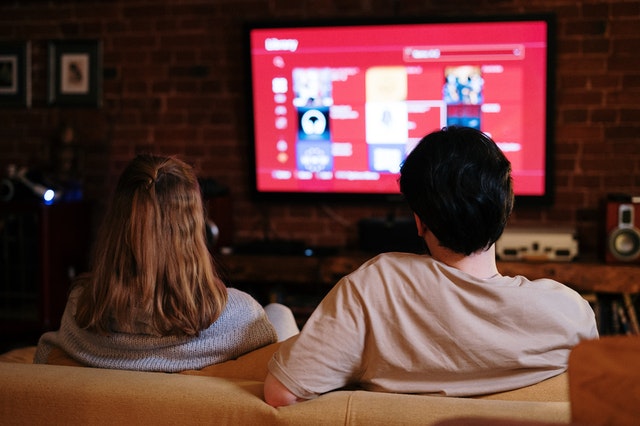If you love movies, television shows, or sports, having your own home theater room is a great way to enjoy a more immersive experience. Designing a home theater room comes with many fantastic benefits, and it gives you a separate space to relax and enjoy your favorite form of entertainment. You’re able to provide guests with an awesome experience, and it’s also a wonderful way to relax, unwind, and enjoy a little bit of “me time.” These rooms are also a great spot for dedicated gamers. A personal home theater can also keep the kids happy and entertained. A media room is not the same as a home theater room and typically won’t have things like light-blocking or acoustic insulation. Overall, a media room is multipurpose, while a home theater room is designed solely to watch media, play video games, or listen to music. Read on to learn more about how to create your very own home theater room so that you can entertain in style.
Planning and setup for a home theater room

Here are some tips to help you get started on your home theater room plans:
- Budgeting: Every home project starts with a budget, so begin by setting limits on how much money you’re willing to spend; to figure out a budget you’ll need to have an idea about how much home theater equipment costs. Look for affordable TVs, sound systems, and media players, as well as affordable furniture. Decide which thing is most important to you, whether it’s the comfort of leather movie theater chairs or a high-tech flat-screen TV. This will make it easier to prioritize and decide where most of your money should go.
- Find the perfect location: Decide where you want your home theater to be set up. Consider using a basement, attic, or garage since these areas tend to have the least windows and are located away from the rest of your home. Depending on the size, a spare bedroom or other empty room can also work nicely.
- Decide on your furniture: Your home theater room furniture will depend on how large the room is and the audience you entertain. A set of comfortable reclining theater chairs with a console is a good option for any design. They come individually or in rows and can be straight or curved. Measure the size of the room to determine how many chairs you can add and what their size should be.
- Soundproofing: The key to a great experience is ensuring the home theater room has adequate soundproofing. Add some acoustic sound-deadening drywall and use sound-absorbing materials like thick carpet and heavy curtains. You can also install insulation or special acoustic panels in the walls to keep the sound dampened and contained.
- Lighting: The proper lighting can make your home theater more authentic. Install recessed lighting, wall sconces, and LED lighting strips along the floor to make it feel like a real theater. A few table lamps next to each chair will also help provide additional task lighting when it’s needed.
- Snack bar: Don’t forget the snacks when setting up your home theater. Consider adding a cool popcorn makers on wheels and a mini-fridge so you’ll always have cold beverages close at hand.
- Cable management: Keep cords and cables safely out of the way with good cable management. Cord managers and zip ties can keep bundles of cords together, while a raceway along the floor keeps long wires and cables safely hidden from view.
Home theater tech essentials

No home theater is complete without the right tech. Remember these essentials as you set everything up:
- Sound: Look for a high-quality surround sound system with plenty of speakers. The system should include left and right front speakers, a center speaker, a subwoofer, and left and right rear speakers for the ultimate sound output. You’ll also want a preamplifier that allows you to adjust the sound and tweak it depending on what you’re watching.
- Screen and projector: If you really want to create an actual theater experience, consider adding a movie screen and projector rather than using a TV set. You can find affordable screens much larger than a standard TV set since many come in at around 100-120 inches in size. Don’t forget to choose a digital projector that makes it easy to watch various media. You can find a projector with excellent brightness, crisp color production, and some models also have 4K resolution. The best part is this equipment tends to cost less than a quality 4K UHD TV. However, if you do decide to choose a TV, think about what makes a great TV.
- Equipment: Other home theater equipment you’ll need includes a sturdy stand that can hold all of your electronics. Other equipment to consider consists of a DVD player and CD player, a soundbar, and a media streaming device so you can watch a variety of items remotely without using actual DVDs or film reels.
- Cables: Make sure you have all the proper cables, so everything is connected. Color-coded cables make it easy to determine which ones go to which equipment. You’ll also need some speaker wire so you can arrange your speakers in the room while keeping them connected to the sound system.
- Smart remotes and lighting: A smart or universal remote makes it easy to control everything with just one item. There are also smart remote apps you can download on your smartphone. Smart lighting is also a good choice since you can control the light’s colors, brightness levels, and more with a touch of a button.
Home theater décor

Adding décor to your home theater will make it more unique and exciting. Consider these ideas when it’s time to spruce up your theater room.
- Movie posters: Pick out a few promotional posters of your favorite movies and display them throughout the room. Whether it’s drama, action, or horror, movie posters are an awesome addition to a home theater. Look for poster frames that will protect them and make hanging them up on your walls easier.
- Memorabilia: If you happen to be a collector, have fun displaying some of your treasured memorabilia. This can be anything from movie promotional items to ticket stubs you’ve collected from watching some of your favorite films.
- Figurines: From superheroes to classic movie characters, display a few figurines on wall shelves in your home theater for a fun touch. This is a great way to add visual interest and create a movie-themed space.
- Film collection: Store and display your DVD film collection in the home theater room. You can use anything from built-in bookcases to wall shelving. Get creative and develop some ways to store your collection in the room while saving floor space.
- Painting: When painting the walls in your home theater, keep the color as dark as possible. Dark gray, brown, a deep burgundy, or black are all excellent choices. This will prevent the light from reflecting off the walls, which can cause a nagging glare.
- Wall art: Hang some wall art in the room, including fun movie-themed items like paintings of movie reels, classic theater icons, or a painting from the famous Hollywood era. Theater signs and metal wall sculptures are a fun way to spruce this space up.
Pro home theater tips: what to avoid

Now that you know how to design a home theater, keep these tips in mind, so you know what to avoid:
- Don’t buy the latest technology without doing some research first. Read customer reviews and make sure you choose user-friendly components.
- Avoid going over your budget and try to stick to affordable items. You can always make improvements later when you have more money to spend. Use the internet to find 9k movies to watch with your friends and family.
- Try not to arrange your home theater seating too close or too far away from the screen. Experiment with your seating and room layout before everything is officially installed to ensure you’re getting the best, most comfortable viewing experience.
- Don’t ignore the location of the door, and make sure it’s located at the back of the room. This will prevent people from getting up and walking in front of the screen if they need to leave or enter.
- Don’t forget to pay attention to the lighting and acoustics. The right lighting and proper sound insulation will ensure that every movie, game, or TV show you watch is optimal.
- Don’t forget to include quality surge protectors as part of your equipment purchase. With so much to plug in, you’ll need a few of these to keep everything connected safely at the same time.
Protect your home theatre room
A home insurance policy primarily provides coverage for property damage and loss resulting from events like fire, theft, vandalism, or natural disasters. It typically covers the structure of the home and its contents. While a home theater room could be considered part of the home’s contents, it may have coverage limitations depending on the specifics of the insurance policy. It’s important to review your home insurance policy or consult with your insurance provider to understand what is covered and to what extent.
If you have a dedicated home theater room with expensive audio-visual equipment, you might consider adding additional coverage, such as specialized electronics insurance or an endorsement to your home insurance policy, to protect against specific risks associated with that equipment. These specialized policies or endorsements can provide coverage for damage, theft, or other risks specific to your home theater equipment.
To protect a home theater room with home insurance, you can take the following steps:
- Review your policy: Start by reviewing your existing home insurance policy to understand the coverage it provides for personal property or contents. Confirm if the policy includes coverage for electronics and audio-visual equipment. Take note of any coverage limits or exclusions that may apply.
- Document your equipment: Create an inventory of the audio-visual equipment in your home theater room, including make, model, and estimated value. Take photos or videos of the equipment, showing their condition and any unique features.
- Determine coverage needs: Evaluate the value of your audio-visual equipment and consider if your existing home insurance policy provides adequate coverage. If the coverage limit is insufficient, contact your insurance provider to discuss options for increasing the coverage or adding an endorsement or rider specifically for your home theater room.
- Consider special endorsements or riders: Some insurance companies offer specialized endorsements or riders for high-value electronics or home theater equipment. These additional coverages can provide broader protection and may include coverage for accidental damage, power surges, theft, or breakdowns. Inquire with your insurance provider about these options and determine if they are suitable for your needs.
- Provide accurate information: When applying for or renewing your home insurance policy, provide accurate and detailed information about your home theater room and its contents. This ensures that the insurance company has a clear understanding of the equipment you own and can provide appropriate coverage.
- Implement security measures: Install security measures such as burglar alarms, security cameras, or home monitoring systems in and around your home theater room. These measures can help deter theft and provide additional protection, potentially qualifying you for premium discounts on your home insurance policy.
- Maintain proper maintenance: Regularly maintain and care for your audio-visual equipment to minimize the risk of damage or breakdowns. Follow manufacturer recommendations for cleaning, servicing, and storing the equipment properly.
With a good plan and proper budgeting, you can design your very own personal home theater room. Remember to choose the right equipment to make every viewing fun, authentic, and enjoyable. If for any reason you’re unable to do some of the minor renovations yourself, consider hiring a handyman who can help you with soundproofing, lighting, painting, and shelving installation. A home theater can provide you with an awesome space to entertain, relax, and forget about the worries of everyday life, all without ever having to leave your home.




